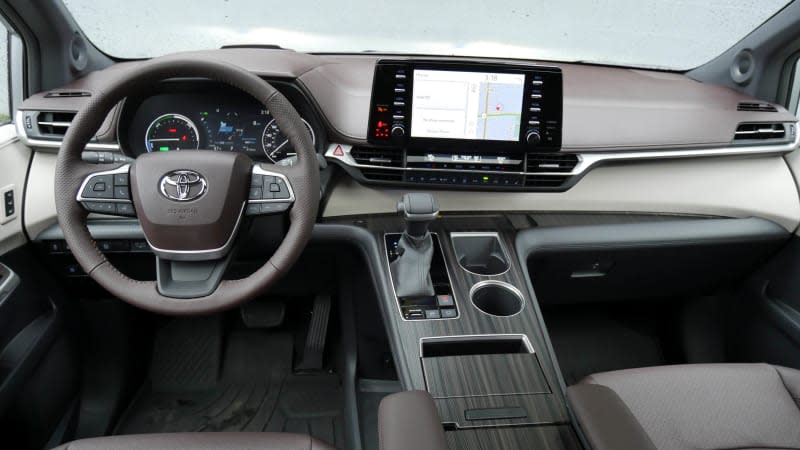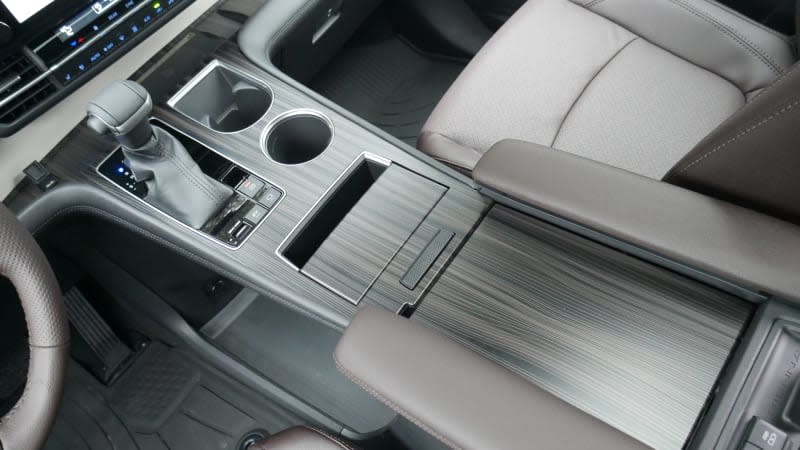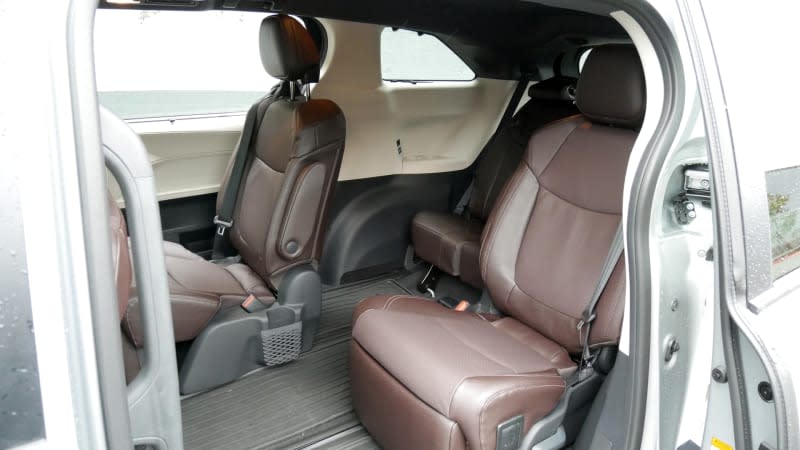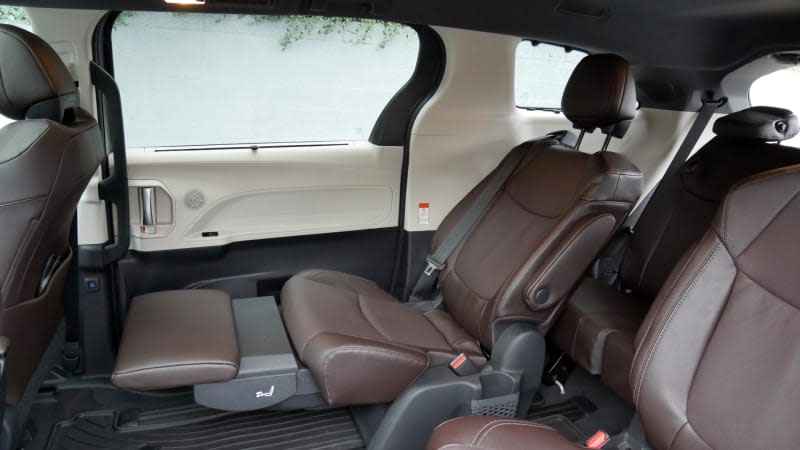2022 Toyota Sienna Review | 36 mpg is a gigantic advantage

It's rare for one element to singularly vault an entire car toward class-leading status, but that's exactly the situation with the 2022 Toyota Sienna. You see, every version is a hybrid that gets either 36 or 35 mpg compared to the 22 mpg returned by its gas-only, V6-powered competitors. That's an enormous gas- and money-saving advantage, and considering how people usually drive minivans, it grossly outweighs the fact that it's down on power.
At the same time, the rest of the Sienna is fully competitive among minivans, with other strong points being exceptional cabin storage, a bold interior design and versatile Super Long Slide second-row seats that are especially good for parents with older kids. The Sienna's handling is also sharper than its competitors, while its feature content, cargo space and safety are similarly strong. Therefore, with most other elements being equal or at least similar enough, the Sienna's massive fuel economy advantage becomes a deciding factor.
Of course, there is one competitor that gives it a run for its money: the Chrysler Pacific Hybrid, a plug-in model that offers all-electric range. It can therefore be even more efficient than the Sienna, but then it's also pricier (and harder to come by at dealers). In our comparison test between the two, it was nearly a tie with the edge going ever so slightly to the Sienna. Either way, we'd consider both of these first when looking for a minivan.
Interior & Technology | Passenger & Cargo Space | Performance & Fuel Economy
What it's like to drive | Pricing & Features | Crash Ratings & Safety Features
What's new for 2022?
The Sienna adds a new, unique trim level for 2022: the Woodland Edition. It gets a 0.6-inch increase in ground clearance thanks to unique shocks and springs, which may not seem like much, but the resulting 6.9 inches compares to 4.5 in the Honda Odyssey and 5.4 in the Chrysler Pacifica. It also gets its own 18-inch wheel/tire package, darkened exterior trim, exclusive colors, roof rail crossbars and a 1,500-watt power outlet. There are only minor feature content upgrades elsewhere in the Sienna lineup after it was all-new last year.


What are the Sienna interior and in-car technology like?
The Sienna's front cabin is shockingly high-style for a minivan, with a design that's an even bolder departure from the norm than the new, surprisingly lux Kia Carnival. The controls are canted ever-so-slightly toward the driver, while the high center console provides more of a car- or SUV-like feel. Nevertheless, that console is really just a bridge over a vast open canyon ripe for whatever you want to put down there (likely a purse). There are a number of other handy places up front to stow things, as well, which we go over in this deep dive review of the Sienna's interior storage.
Unfortunately, we've found that cabin quality differs widely depending on trim level. The upper XSE, Limited and Platinum (above and below right) trim levels get padded, leather-look trim across the doors and a modern wood-look trim level across the console. By contrast, the lower XLE trim level (above and below left), gets hard textured plastic instead of the padded stuff and bizarre rust-colored plastic trim with embossed lines and metallic specks. It looks cheap, and it’s the difference between the Sienna being better than its competitors and being a little bit worse.
As for technology, all the usual features are present and the 9-inch touchscreen is easily seen, reached and operated. It's just outdone by every competitor's system, especially Chrysler's and Kia's. The rear seat entertainment system also offers only one roof-mounted screen, versus the dual seatback screens of the Chrysler, and its USB ports are not as conveniently located as those of the Chrysler and Kia.


How big is the Sienna?
The Sienna is comparable in size to the other minivans. We didn't find it any more maneuverable or less cumbersome to drive in tight places, and it offers the same sort of vast cargo space behind its third-row seat. Now, its specs indicate far less cargo space when the third row is lowered as well as when the second-row seats are removed, but we suspect this is due to a difference in the way Toyota measures cargo capacity. In reality, we think it's effectively similar.
Really, minivans differ in terms of their second-row seating concepts. The Sienna offers a choice of two (and is most similar to the Kia Carnival). The eight-passenger model is probably better suited to parents with smaller kids since it comes with a removable second-row middle seat that you can affix a child seat to while keeping the outboard seats open. The seven-passenger setup found on upper trim levels features the new “Super Long Slide” second-row captain’s chairs, which slide further than its competitors by a considerable amount. Slid to the rear, they provide enough legroom for NBA forwards to kick back and relax. They also slide forward all the way to the front seats, making it more likely to fit whatever you need inside without moving the seats (while being more comfortable than the non-hybrid Chrysler Pacifica's Stow 'N Go seats). A second lever folds the seat cushion up and the seatback forward to either provide an easy ingress into the third row, or to maximize cargo volume even further.
There are certainly advantages to Stow 'N Go (for those who prioritize cargo-carrying versatility) and Honda's "Magic Slide" second-row (for those with multiple small children), so there isn't a right or wrong answer here. Choice is good. In this case, we think the Sienna's concept is best suited for families with older kids.




What are the Sienna fuel economy and performance specs?
Every 2022 Toyota Sienna is a hybrid. There's a 2.5-liter four-cylinder and two electric motors, plus a third added to create the available all-wheel-drive system. Its battery recoups energy from the brakes and engine (it's not a plug-in hybrid like the available Pacifica Hybrid, which has all-electric range and a higher price). Total system output is 245 horsepower, which is less than its V6-powered competitors.
Fuel economy is massively better, though. Toyota estimates the Sienna will get 36 mpg combined with front-wheel drive in EPA testing and 35 mpg combined with AWD. We averaged 39.4 mpg on a 454-mile road trip without making any effort to drive efficiently. The Odyssey, Carnival and V6-powered Pacifica get 22 mpg combined. That's a difference that should save you hundreds of dollars on gas every year, and given the way people usually drive minivans, seems to greatly outweigh whatever performance the Sienna gives up to its rivals.


What's the Sienna like to drive?
The new, hybrid-only Sienna certainly won't be the top choice for lead-footed minivan drivers, but that's a minority, if possibly an oxymoron. For everyone else, power should be perfectly adequate, while the instantaneous nature of the electric torque actually makes it feel quick off the line. You do have to live with droning from the e-CVT, though, especially when accelerating onto the highway.

 Yahoo Autos
Yahoo Autos 
